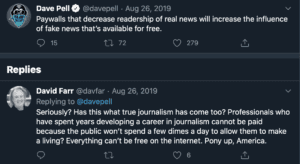
Everyone has experienced it. While searching for information online you finally come across a news headline that looks like it will provide the exact answers to the questions you’ve been itching to know. Excitedly, you click on the link and begin reading, but before you can finish the first couple of lines – Pop! – A paywall obstructs the rest of the article and you are forced to either pay a fee for full access or abandon the site and continue your search elsewhere. Though this encounter may seem only like a trivial inconvenience, the ethics of news paywalls extends far past simple annoyances.
Around the early 1990s, owning a computer was becoming commonplace for many American households. To keep up with the times, mass media outlets began creating websites where readers could now access stories on the Internet in addition to traditionally printed newspapers. At first, these companies were just happy to be part of the digital scene, but soon, profitability became an issue. Because information was now available for free from the comfort of one’s own home, many consumers stopped going out to purchase newspapers and consequently, news outlets saw huge declines in profits. Online forums such as Craigslist also took a large bite out of the classified advertising revenues that traditionally supported newspapers. To make up for such losses in print media, online news companies turned to digital advertising. While this method worked for a while, the irritating experience of being bombarded by noisy pop-ups led to the rise of users installing ad-blocking software which has “severely damaged the ability of such news sites to make money from advertising” (Felle, 2016).
Due to the problems surrounding digital advertising, “publishers have embraced a ‘pivot to readers’ and explored ways to generate more revenue from [the audience itself through] subscriptions and memberships” – thus, the paywall was born (Bilton, 2018). In 1996, The Wall Street Journal was the first to implement a “hard paywall,” which required readers to pay a subscription upfront or be blocked from accessing articles completely (Simon & Graves, 2019). Since then, new “soft” paywall models have been developed, such as the popular “metered paywall” where readers are given a limited number of free articles per month before the user is required to purchase access to the newspaper’s content (Howard, 2018). Regardless of the type of paywall used, the result is the same: Readers must pay the news company directly to receive access to information. According to Reuters Institute, now “more than two-thirds of leading newspapers (69%) across the E.U. and U.S. are operating some kind of online paywall, a trend that has increased since 2017, especially in the U.S. where this has increased from 60% to 76%” (Simon & Graves, 2019).
As intended, paywalls provide an opportunity for news outlets to turn a profit without relying on digital advertising, which results in a number of advantages. Clearly, in an era where ad-blockers negatively affect ad revenue, paywalls can help media producers survive in a free-market economy. This is especially important for small-scale operations as ad revenue is typically concentrated among a few corporate giants like Facebook and Google. Aside from simply breaking even, these profits can also allow businesses to flourish, as extra money means better pay for working journalists and equipment upgrades which can help create new and better content for consumers.
Furthermore, the paywall method has given media providers a new sense of independence. Because sponsors want as many people to see their ad as possible, they tend to only purchase space on sites which generate a lot of web traffic. In an effort to meet traffic quotas which will impress advertisers and gain revenue for the business, some news outlets have downgraded their journalistic quality by promoting sensationalized clickbait articles which promise to lure large audiences to their site. Implementing paywalls and bypassing the intermediary of digital advertising altogether may reverse this trend. As Sara Libby, managing editor of The Voice of San Diego, explains: “There is absolutely a freedom to cover the kinds of stories we think are important because we’re not beholden to advertisers [or] tethered to page views. Obviously, we want our work to reach as many people as possible, but we don’t feel pressure to add a Justin Bieber headline just for the traffic” (Zara, 2013).
 Despite the argument that paywalls produce better journalism, it has also been argued that they contribute (perhaps indirectly) to the proliferation of misinformation online. Due to the advent of sites like Facebook, Twitter, and various blogging platforms where anyone can be a content producer with relative anonymity and ease, “free, less reliable news sources and aggregators can push articles… that go viral in a matter of seconds whether they are completely true, properly researched, or not” (Concept47, 2019). This allows for fake news to be spread quickly and with little difficulty while real news is trapped behind paywalls.
Despite the argument that paywalls produce better journalism, it has also been argued that they contribute (perhaps indirectly) to the proliferation of misinformation online. Due to the advent of sites like Facebook, Twitter, and various blogging platforms where anyone can be a content producer with relative anonymity and ease, “free, less reliable news sources and aggregators can push articles… that go viral in a matter of seconds whether they are completely true, properly researched, or not” (Concept47, 2019). This allows for fake news to be spread quickly and with little difficulty while real news is trapped behind paywalls.
Though some have positioned this issue as a matter of personal choice which can easily be overcome by consumers “ponying up” and “spending a few dimes” for access to real, high-quality news, the reality may not be so simple (Farr, 2019). Studies have shown that “the people who pay for news in the U.S. are wealthier and better educated than those who do not” (Masnick, 2019). Thus, “putting up a news paywall can cause completely unacceptable asymmetries in the quality of news accessible to people with different financial circumstances… [which goes] against every imaginable principle of democracy” (Giovannetti-Singh, 2017). By hiding content behind a paywall, those who cannot afford to pay a subscription are restricted from accessing information which may potentially affect their lives, leaving the already disadvantaged in society even worse off as they are stuck with unreliable news sources as their only sources. In this way, “the paywall is inherently in conflict with journalism’s primary goal: to educate and inform the public about important issues” (Howard, 2018).
While paywalls have the potential to free news outlets from the tyranny of advertisers, thus keeping them in business and safeguarding their journalistic integrity, this production of high-quality news may be ultimately useless if only a small percentage of society is privileged enough to access it. In the end, the ethics of paywalls may come down to the difference between what is good for business and what is good for society. As Mannal Babar (2019) poignantly questions, “We must ask ourselves as journalists and content creators whether financial solvency is more important than the truth we are pursuing… But is there a future for journalism that doesn’t come at the expense of public information and news?”
Discussion Questions:
- What are the ethical issues involved with news paywalls? What central values are in conflict or at stake?
- What are the best arguments for and against news paywalls? Which one do you find more compelling, and why?
- Are news outlets primarily businesses or public services? Who should support news organizations, especially in the chaotic online environment?
- Is there a creative solution to ensuring journalists are paid and news companies stay afloat that does not rely on the sensationalism of advertising or neglecting the information needs of the economically disadvantaged?
Further Information:
Babar, M. (2019, October 7). “Writer’s Block: How Media Paywalls Affect Our Worldview.” The Daily Targum. Available at: https://www.dailytargum.com/article/2019/10/media-paywalls-change-the-news
Bilton, R. (2018, February 1). “Learning from The New Yorker, Wired’s New Paywall Aims to Build a More ‘Stable Financial Future.’” NiemanLab. Available at: https://www.niemanlab.org/2018/02/learning-from-the-new-yorker-wireds-new-paywall-aims-to-build-a-more-stable-financial-future/
Farr, D. (@fardav). (2019, August 26). “Seriously? Has this what true journalism has come too? Professionals who have spent years developing a career in journalism cannot be paid because the public won’t spend a few dimes a day to allow them to make a living? Everything can’t be free on the internet. Pony up, America.” [Tweet]. Available at: https://twitter.com/davepell/status/1166139262980374529
Felle, T. (2016, February 22). “Are Paywalls Saving Journalism?” The Conversation. Available at: https://theconversation.com/are-paywalls-saving-journalism-53585
Giovannetti-Singh, G. (2017, November 6). “Are News Paywalls Propagating Fake News?” The Cambridge Student. Available at: https://www.tcs.cam.ac.uk/are-news-paywalls-propagating-fake-news/
Howard, R. (2018, January 5). “Three Reasons Why Journalism Paywalls Still Don’t Work.” Quartz. Available at: https://qz.com/1173033/the-psychology-behind-why-journalism-paywalls-still-dont-work/
Masnick, M. (2019, June 21). “The Paywall Conundrum: Even Those Who Like Paying for News Don’t Pay for Much News.” TechDirt. Available at: https://www.techdirt.com/articles/20190615/01285842407/paywall-conundrum-even-those-who-like-paying-news-dont-pay-much-news.shtml
Concept47. (2019, May 28). “Are Online Paywalls Helping the Proliferation of Fake News?” Available at: https://medium.com/@concept47/are-online-paywalls-helping-the-proliferation-of-fake-news-ee3084b639e6
Simon, F. & Graves, L. (2019, May 23). “Newspaper Paywalls Slowly Increasing, but Online News is Still Mostly Free.” Reuters Institute. Available at: https://reutersinstitute.politics.ox.ac.uk/risj-review/newspaper-paywalls-slowly-increasing-online-news-still-mostly-free
Zara, C. (2013, January 5). “Paywalls, Profits and Pageview Journalism: Ethics in The Digital Age.” International Business Times. Available at: https://www.ibtimes.com/paywalls-profits-pageview-journalism-ethics-digital-age-993704
Authors:
Kat Williams & Scott R. Stroud, Ph.D.
Media Ethics Initiative
Center for Media Engagement
University of Texas at Austin
February 15, 2021
Images: NeONBRAND on Unsplash / Twitter.com screencapture
This case was supported by funding from the John S. and James L. Knight Foundation. These cases can be used in unmodified PDF form in classroom or educational settings. For use in publications such as textbooks, readers, and other works, please contact the Center for Media Engagement.
Ethics Case Study © 2021 by Center for Media Engagement is licensed under CC BY-NC-SA 4.0



